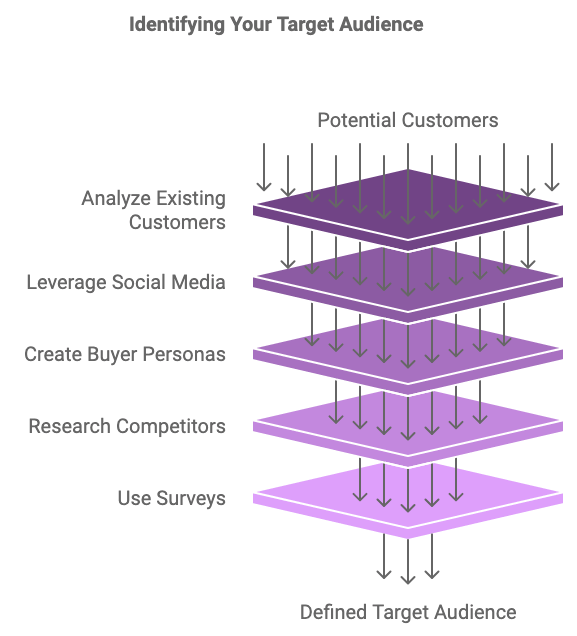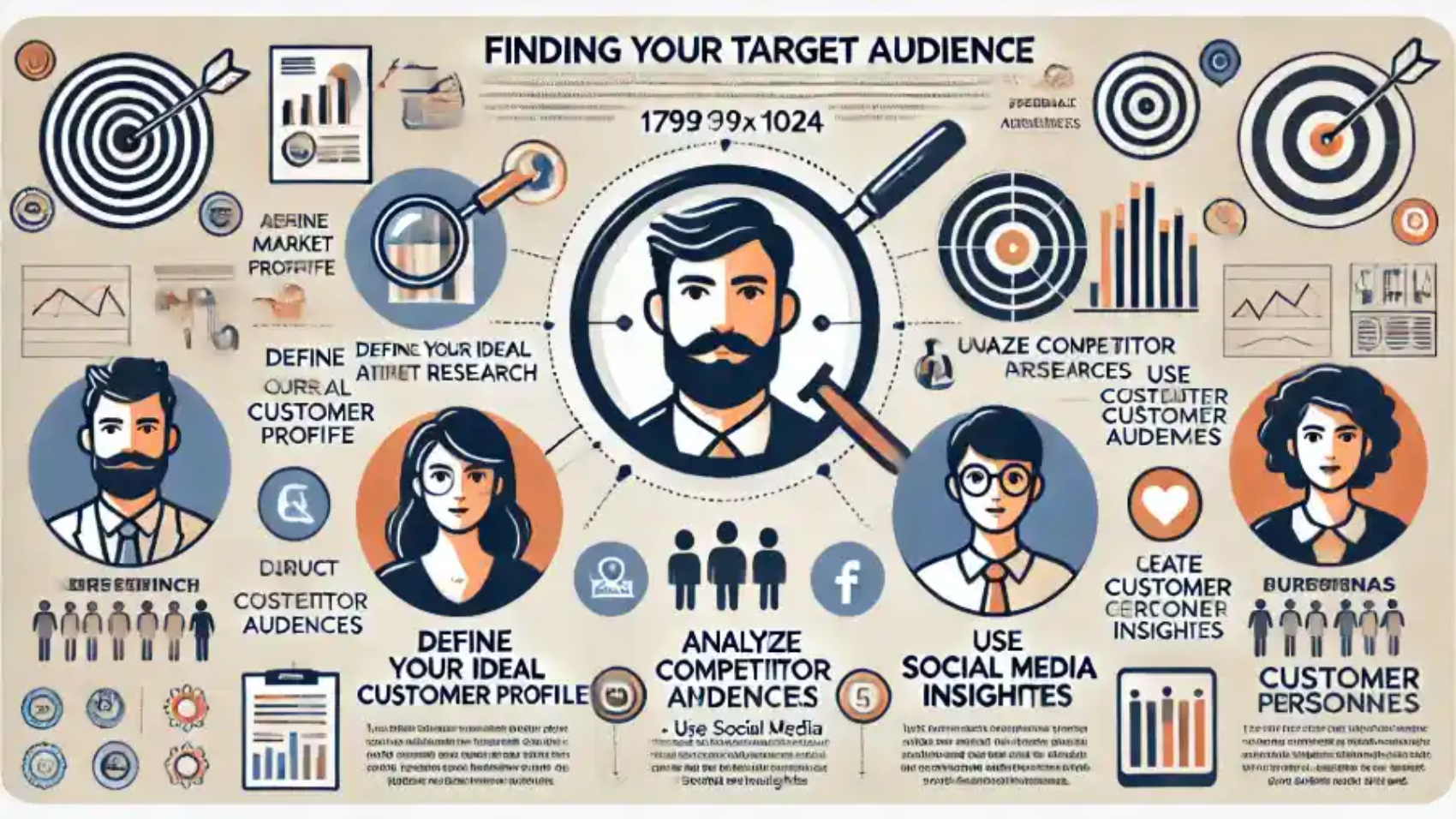Finding your target audience is essential for any marketing strategy, but it’s easier said than done. With today’s vast online world, businesses must strategically define and reach their ideal customers to create effective campaigns that drive results. This guide provides five actionable tips to help you identify and engage your target audience effectively.
What is a Target Audience?
A target audience is the specific group of people most likely to be interested in your product or service. By defining characteristics such as age, location, interests, and buying behavior, businesses can ensure their marketing reaches those who are most receptive.
Quick Tips to Find Your Target Audience
- Analyze Your Existing Customer Base
- Leverage Social Media Insights
- Create Detailed Buyer Personas
- Research Your Competitors’ Audiences
- Use Surveys and Direct Engagement
Analyze Your Existing Customer Base
One of the most effective ways to find your target audience is by examining your current customers. Understanding their demographics, behaviors, and preferences can reveal who resonates most with your products or services.
- Demographic Analysis: Use tools like Google Analytics or social media insights to see the age, location, and gender distribution of your current audience.
- Behavioral Patterns: Analyze how these customers interact with your content—are there specific pages they frequent or products they repeatedly purchase?
- Feedback Collection: Conduct surveys or feedback sessions to understand what motivates their loyalty and what they expect from your brand.
Focusing on your existing customer base can help you create a profile of your most engaged customers, which can guide your marketing efforts moving forward.
Leverage Social Media Insights
Social media platforms offer robust analytics to help identify your target audience’s interests and habits. By examining data from your social media accounts, you can get a clearer view of your followers and their preferences.
- Audience Insights on Platforms: Most platforms, like Facebook, Instagram, and Twitter, provide data on your followers, such as age ranges, geographic locations, and engagement levels.
- Content Performance Analysis: Track which types of posts receive the most engagement (likes, shares, comments) to understand the content your audience finds most compelling.
- Listening Tools: Social listening tools like Hootsuite or Brandwatch can help you track mentions, hashtags, and keywords relevant to your brand. This approach allows you to see what your audience discusses and what problems they need solutions for.
Using these insights, you can refine your messaging and content strategy to align with your audience’s expectations.
Create Detailed Buyer Personas
Buyer personas are fictional yet realistic representations of your ideal customers. Developing these personas can help you understand and anticipate your audience’s needs, pain points, and preferences.
- Gather Data: Use data from Google Analytics, social media, and customer feedback to gather relevant demographic information.
- Identify Pain Points and Goals: Think about the challenges and objectives your product or service addresses for customers.
- Assign Realistic Names and Stories: Give each persona a name, background, and storyline to make it easier to remember and understand. For example, “Marketing Mary,” a 30-year-old marketing manager looking to streamline her company’s outreach, is a persona with specific challenges and needs.
Creating personas helps you put a face to the data, making it easier to tailor content and campaigns that resonate with real individuals.
Research Your Competitors’ Audiences
Competitor analysis can provide valuable insights into audience behaviors and preferences within your industry. By understanding who your competitors are targeting and how they’re positioning themselves, you can discover potential market gaps.
- Analyze Competitor Content: Look at what type of content competitors publish, which channels they prioritize, and how their audience engages with them.
- Study Their Followers: Check out who follows and interacts with your competitors on social media. These followers likely have similar interests and could be part of your target audience.
- Leverage Tools: Tools like SEMrush and Ahrefs can help you analyze competitor keywords, popular content, and backlink sources to see what’s driving traffic to their sites.
By identifying your competitors’ audience strategies, you can differentiate your brand and potentially capture untapped market segments.
Use Surveys and Direct Engagement
Directly engaging with your audience can provide deep insights that data alone might miss. Surveys, polls, and even casual interactions on social media or during live events can help you gather valuable feedback on your audience’s preferences and pain points.
- Conduct Surveys: Use platforms like SurveyMonkey or Google Forms to ask specific questions about your customers’ needs and preferences.
- Engage on Social Media: Host Q&A sessions or use Instagram Stories polls to engage followers in a low-pressure environment.
- Utilize Customer Interviews: For an in-depth understanding, consider one-on-one interviews with a few loyal customers. This approach allows you to dive into their motivations and how they use your products.
Collecting feedback directly from your audience helps you stay in touch with their evolving needs, allowing you to tailor your messaging and product offerings accordingly.

Benefits of Knowing Your Target Audience
For your marketing to succeed and your business to grow, knowing your target audience is essential. Your target audience is the specific group of people most likely to be interested in your product or service. Understanding their needs and preferences allows you to create focused, effective marketing that truly resonates. Here’s why it matters:
1. Better Marketing Strategies
Knowing your audience helps you create ads, emails, and social media posts that they actually care about. Instead of guessing what they like, you’ll know what to say and where to say it. According to SEMrush, businesses that understand their audience get higher engagement and reach more people effectively.
Example:
If you run a skincare brand for young adults with acne, you can create posts that speak to their concerns and struggles. This makes your brand more relatable and valuable to them.
2. Improved Customer Experience
People want to feel understood by the brands they buy from. When you know your audience, you can create a more personalized experience for them, leading to happier and more loyal customers. HubSpot points out that brands with a focus on personal experience build stronger connections with their customers.
Example:
Companies like Netflix and Spotify create customized recommendations for their users based on their preferences, keeping them engaged and coming back for more.
3. Higher Conversion Rates
Understanding your audience means you can create messages and calls to action (CTAs) that speak directly to their needs, which increases the chances of them taking action. WordStream notes that when businesses connect with their audience’s needs, conversion rates improve significantly.
Example:
For an online store, knowing that most of your audience shops on mobile can lead you to improve your mobile website. This simple change can make it easier for them to shop, boosting sales.
4. Cost-Effective Marketing
Knowing your audience helps you save money. You’ll focus your marketing budget on the right people, not on everyone. This means you’ll get more results from every dollar spent. Adobe emphasizes that targeting prevents wasting money on ads for people who aren’t interested, making your marketing more efficient.
5. Stronger Brand Loyalty and Trust
When people feel like a brand understands them, they’re more likely to stick around. This loyalty means they’ll choose your brand over others and might even recommend it to their friends and family. According to SEMrush, loyal customers not only buy more but also help spread the word about your brand.
Example:
Apple is a great example of brand loyalty. They know their audience well and consistently deliver products that meet their needs, building a fan base that’s extremely loyal.
6. Competitive Advantage
In today’s crowded market, knowing your audience can give you a strong advantage over your competitors. When you consistently connect with your customers, they’ll think of your brand first. WordStream says this is especially important in competitive industries, where knowing your audience helps you stand out.
Final Thoughts
Defining and finding your target audience isn’t a one-time task—it’s an ongoing process that requires regular analysis and adaptation. By understanding who your ideal customers are, how they interact online, and what they need, you can build stronger relationships and achieve better marketing results.
Implementing these five tips will help you create more effective campaigns and, ultimately, grow your business by connecting with the people who matter most.


[…] the right 3PL for a small business is a crucial step towards achieving success. By considering factors such as industry experience, […]